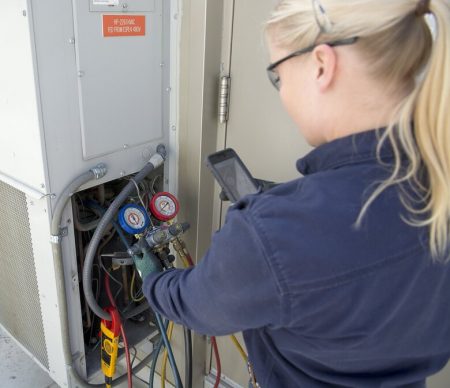The following Seattle Times article by Geoff Baker features an interesting and relevant conversation about indoor air quality and HVAC system solutions to minimize virus presence and spread within buildings. NEEC member businesses Trane, MacDonald Miller and McKinstry are all mentioned for their expertise on the topic.

Greg Smith had little time to spare when studies began suggesting the novel coronavirus can spread through shared air within buildings.
As a facilities management director for the King County Library System, Smith overseas the heating, ventilation and air conditioning (HVAC) systems in about four dozen buildings currently closed to non-staffers. He contacted the county’s HVAC maintenance contractor and they tested each of the systems — the oldest about 15 years — to ensure maximum air flow and filtration before library visitors are allowed back in.
“The news changes every day on this stuff,” Smith said. “What’s good. What’s bad. What people recommend and what scientists have said. So, yeah, we’re tracking it pretty closely.”
The coronavirus pandemic has challenged an HVAC industry suddenly asked to help ensure the air in offices, stores and other buildings is safe for occupants.
Given the cost of completely replacing HVAC systems can run $100,000 to $500,000 for smaller buildings and into the millions for bigger ones, specialists are instead finding creative ways of improving what’s already there.
Rod Kauffman, president of the local Building Owners and Managers Association (BOMA), a trade group with membership comprising about 70% of Seattle and Bellevue office buildings, said most members have increased their fresh air intakes. Others have upgraded filters and some have even installed the more expensive UV light disinfecting devices within systems.
Their scramble to make changes increased after more than 200 researchers recently pushed the World Health Organization to recognize that the coronavirus can spread through air currents. That followed a springtime University of Oregon study which found the virus present in a quarter of the vents in hospital rooms where COVID-19 patients were treated — suggesting it might spread through air separate from an infected person’s location.
Opinions differ among experts over how serious the spread could be. But with buildings hoping to ramp up tenant occupancy soon — with workers often struggling in temporary home setups — many are taking proactive steps to avoid future virus outbreaks that might shut them down anew.
For Smith, that meant upgrading the standard filters within library HVAC systems to a version that traps smaller air particles and droplets.
He also began “flushing” the libraries of interior air more frequently throughout the day and replacing it with outside air that is cooled and then recirculated. Every evening, the buildings are additionally flushed for eight hours at a time.
“Our energy costs are going to go up,” he said of the added expense of heating and cooling imported air to room temperature. “But the safety benefits for everybody else are far more important.’’
Rory Olson, vice president of service operations for MacDonald-Miller Facility Solutions, the HVAC specialists working with Smith, said the business has been “bombarded with calls’’ from building managers since April. That’s when the American Society of Heating, Refrigerating and Air-Conditioning Engineers (ASHRAE) warned that HVAC mitigation might be needed to prevent people from becoming infected by airborne coronavirus droplets.
“Transmission of (coronavirus) through the air is sufficiently likely that airborne exposure to the virus should be controlled,” ASHRAE wrote. “Changes to building operations, including the operation of heating, ventilating, and air-conditioning systems, can reduce airborne exposures.”
Olson’s company, which has 4,700 Seattle-area facility customers, can’t guarantee it can eradicate the spread of coronavirus droplets in buildings, largely because even scientists don’t know enough about the virus.
“The recommendation we’ve been giving most people is, ‘Hey, we’re not virus experts — we’re HVAC experts,’’’ Olson said. “We can’t tell them the things we recommend are going to have a huge impact or any impact at all.
“But we do know about HVAC systems and can give recommendations that make a lot of sense based on what we know … just so they can prepare their building.’’
Solutions are tailored around a company’s specific HVAC system. In general, mitigation falls into four categories: ventilation, filtration, humidity and disinfection.
Proper ventilation is achieved by flushing buildings with outside air using controls typically built into existing HVAC systems. One drawback, beyond soaring energy costs, is warmer summer air and cooler winter air from outdoors can make buildings uncomfortable.
For filtration, buildings will often upgrade from standard filters designed mainly to protect HVAC equipment from larger air particles as opposed to humans from much smaller contaminants. But more powerful filters can also “choke off” certain HVAC systems by catching too many tiny particles and lead to even poorer ventilation if the unit’s fans aren’t strong enough.
Humidity options are mostly for hospitals and medical buildings already set up with systems to control it year-round — with studies showing 43% humidity or higher can typically render most viruses powerless, though whether that works with coronavirus is unclear.
Some ultraviolet light products help disinfect air coming out of HVAC units. But Olson said retrofitting units with additional UV light is very costly and most customers prefer alternatives.
A much cheaper option involves opening up and disinfecting the HVAC units themselves before using them.
“It makes logical sense and it’s not that expensive to do,” Olson said.
Another cost-effective option, long used in residential buildings but gaining traction on the commercial side, is bipolar ionization. A device is retrofitted into an HVAC unit and uses electrically charged atoms to knock down air particles so they can’t get breathed in.
“We’ve done some smoke-testing to see whether it would pull smoke out of the air,” Olson said. “And it pulled smoke out of the air.”
Olson’s company has yet to install any bipolar ionization devices, though it has started recommending the option to customers.
Allan Reagan, CEO of Flix Brewhouse — a chain of dine-in movie theaters in Texas, Iowa, Arizona, New Mexico and Indiana — has hired Trane Technologies to install bipolar ionization for all 87 of the company’s screening auditoriums, at $1,500 apiece. The theaters are closed now, largely due to a lack of new Hollywood films.
Reagan reopened one of his San Antonio theaters for two weeks to try out bipolar ionization and said he’s heard no reports of positive COVID-19 tests for any of the 700 patrons or 50 employees that were on-site. “We tried it out, declared victory, and we’ll come back when we have some good content,” Reagan said.
McKinstry, which designs and maintains HVAC units and other building operating systems, since May has run a “Return with Confidence” program. The program helps McKinstry clients — including 10,000 buildings in the Pacific Northwest — assess their HVAC systems and devise an action plan for needed fine-tuning or upgrades.
Ash Awad, the company’s chief market officer, said most Seattle-area buildings have opted for tweaking HVAC systems as opposed to costly overhauls more prevalent in other parts of the country. Awad said the company is helping clients incorporate additional “ongoing monitoring” within systems to quickly identify any breakdowns that could lead to insufficient ventilation or filtration.
“We’re a strong believer that this is what people should have been doing anyway pre-COVID,” he said. “But with regard to COVID, this is pretty critical stuff to make sure you can look at your tenants, your occupants, your staff … and tell them with confidence: ‘We’ve checked out your building, your space, and it has appropriate air flow, the right movement. And we’re monitoring.”’
Geremy Wolff, the company’s regional director for technical services, oversees McKinstry teams making HVAC assessments for clients. Above all, they stress the need for clients to focus on coronavirus safety fundamentals: mask-wearing, physical distancing, hand-washing and surface cleaning within their buildings. Many buildings now limit elevators to four people or fewer.
“That’s not something we’re experts in, but that is the No. 1 priority,” Wolff said.
The idea being, no HVAC fix will magically protect people if basic safety goes ignored.
Wolff’s teams will help clients figure out whether their systems are performing optimally, then decide on the most suitable filters to use, or how much additional heat in summer or cold in winter the owners will tolerate to get more fresh air inside buildings.
Wolff said most buildings aren’t expecting a return to 100% occupancy and at best probably will be only 40%-50% full. Many solutions amount to educated guesswork based on past studies and experiences with other viruses.
“We’re making assumptions on everything we’re doing because there isn’t a ton of research out there,” Wolff said. “Even with the virus itself, there isn’t anything readily available for people to do research on. … The government’s not handing out (coronavirus) samples to air-handler manufacturers to figure out if their filters can catch it.”
Kauffman, the BOMA president, this past week joined a conference call with the engineers from several buildings to plan an August workshop involving HVAC industry experts and ASHRAE officials. BOMA already held a COVID-19-related workshop in March, drawing 950 participants, but Kauffman said much of “what we thought we knew” has changed.
“We’ve learned more these last four months,” he said. “So, it’s time to kind of re-look at this.”
Bloomberg News contributed to this report.
Geoff Baker: 206-464-8286 or [email protected]; on Twitter: @GeoffBakerTimes. Geoff Baker covers hockey and is a sports enterprise and investigative reporter for The Seattle Times.
